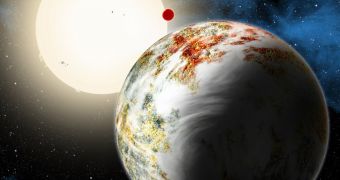This past June 2, researchers with the Harvard-Smithsonian Center for Astrophysics announced the discovery of a planet that they say is best described as the Godzilla of Earths.
The planet in question, whose official name is Kepler-10c, is located in the constellation Draco, at a distance of about 560 light-years from Earth, the Harvard-Smithsonian specialists detail.
What puzzles scientists is the fact that, despite its impressive size, i.e. Kepler-10c has a diameter of about 18,000 miles (about 28,968), this planet is a rocky world. Thus, it is 17 times heavier than Earth.
As detailed on the official website for the Harvard-Smithsonian Center for Astrophysics, this goes against previous assumptions that celestial bodies of this size and weight would attract hydrogen gas and become Jupiter-like.
Other super-Earths have been discovered by astronomers over the years. However, Kepler-10c is so large and heavy that the researchers who found it and documented its make-up have agreed that it would be best to kick things up a notch and call it not a super-Earth, but a mega-Earth.
“We were very surprised when we realized what we had found,” astronomer Xavier Dumusque with the Harvard-Smithsonian Center for Astrophysics commented on the discovery of this planet.
“This is the Godzilla of Earths! But unlike the movie monster, Kepler-10c has positive implications for life,” added researcher researcher Dimitar Sasselov, director of the Harvard Origins of Life Initiative.
This massive rocky world in the constellation Draco was shown to orbit a star similar to our Sun once every 45 days. The system of which it is a part of is estimated to have formed about 11 billion years ago, i.e. just 3 billion years following the Big Bang.
Although scientists are having trouble figuring out how it was that a rocky planet this big came to form, they argue that, all things considered, the discovery of Kepler-10c has high chances to change the way we understand the history of the universe.
“Finding Kepler-10c tells us that rocky planets could form much earlier than we thought. And if you can make rocks, you can make life,” Dimitar Sasselov told the press in a recent interview.
The discovery of this planet was announced during a recent meeting of the American Astronomical Society. While at this meeting, astronomer Lars A. Buchhave made a case of how, all things considered, it was very much possible that this super-Earth was not the only planet of its kind in the universe.

 14 DAY TRIAL //
14 DAY TRIAL //